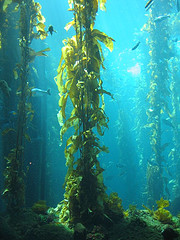Fungi and Algae in Antarctica
Fungi and Algae In Antarctica
News Flash: Antarctica does not only habitat penguins. It gives habitat to fungi, plants, other organisms, and of course; penguins. Let's start from the different types of fungi.
1). There are approximately 1,200 species of fungi in Antarctica.
The different types of fungi is mostly just about two. These are non-lichen-forming, and lichen-forming. If a fungi is non-lichen-forming, this means it is not a type of symbiotic organism. So therefore, a lichen-forming-fungi is a symbiotic organism. This means it has a strong relationship between a number of different species. Look at the picture below.

This type of fungi is the first fungi that was found in Antarctica at around 1847. It is called "peziza kerguelensis". It looks very different in its "real form", but that is because it is in slightly warmer areas. In those areas, it looks like an upside-down mushroom. For more information on other types of fungi in Antarctica and the one above, click on the link below.
https://en.wikipedia.org/wiki/Wildlife_of_Antarctica#Fungi
Plants:




The pictures you see above are of plants and weeds in Antarctica. The first two are different types of weeds, and the last two are the only species of flowers in the ice continent. Well, technically, the first picture is of a "on sea plant" and the second one is of a Tundra plant, which is a type of weed. The third picture is of an "Antarctic Pearlwort", and the last of "Antarctic Hairgrass". Those two are the only type of flowers in Antarctica. They only occur in the summertime and only last for a few weeks, so they are very rare to see. Look at the pictures below to see some of the types of Algae in Antarctica.



Above are pictures of algae and a place where they grow the most, so that you can see the conditions they thrive in most of the time. The first type of algae is part of a Polar Forest. It is unknown at this moment, but is being researched. It is actually a cure to at least one type of cancer. Anyways, the second picture is a type of kelp, "Macrocystis Pyrifera". In other words, it is a type of "brown algae". The third picture is just a picture of an area in Antarctica which is slightly in deeper waters and in slightly warmer ones, so that it suits the thriving conditions of an algae habitat. Here is a small video on a new fact about algae discovered by scientists.
http://www.weather.com/tv/shows/amhq/video/drones-mapping-algae-under-antarctic-ice
Sources: wikipedia.org, weather.com, and www.bas.ac.uk
Posted on 9/23/2015
News Flash: Antarctica does not only habitat penguins. It gives habitat to fungi, plants, other organisms, and of course; penguins. Let's start from the different types of fungi.
1). There are approximately 1,200 species of fungi in Antarctica.
The different types of fungi is mostly just about two. These are non-lichen-forming, and lichen-forming. If a fungi is non-lichen-forming, this means it is not a type of symbiotic organism. So therefore, a lichen-forming-fungi is a symbiotic organism. This means it has a strong relationship between a number of different species. Look at the picture below.

This type of fungi is the first fungi that was found in Antarctica at around 1847. It is called "peziza kerguelensis". It looks very different in its "real form", but that is because it is in slightly warmer areas. In those areas, it looks like an upside-down mushroom. For more information on other types of fungi in Antarctica and the one above, click on the link below.
https://en.wikipedia.org/wiki/Wildlife_of_Antarctica#Fungi
Plants:




The pictures you see above are of plants and weeds in Antarctica. The first two are different types of weeds, and the last two are the only species of flowers in the ice continent. Well, technically, the first picture is of a "on sea plant" and the second one is of a Tundra plant, which is a type of weed. The third picture is of an "Antarctic Pearlwort", and the last of "Antarctic Hairgrass". Those two are the only type of flowers in Antarctica. They only occur in the summertime and only last for a few weeks, so they are very rare to see. Look at the pictures below to see some of the types of Algae in Antarctica.



Above are pictures of algae and a place where they grow the most, so that you can see the conditions they thrive in most of the time. The first type of algae is part of a Polar Forest. It is unknown at this moment, but is being researched. It is actually a cure to at least one type of cancer. Anyways, the second picture is a type of kelp, "Macrocystis Pyrifera". In other words, it is a type of "brown algae". The third picture is just a picture of an area in Antarctica which is slightly in deeper waters and in slightly warmer ones, so that it suits the thriving conditions of an algae habitat. Here is a small video on a new fact about algae discovered by scientists.
http://www.weather.com/tv/shows/amhq/video/drones-mapping-algae-under-antarctic-ice
Sources: wikipedia.org, weather.com, and www.bas.ac.uk
Posted on 9/23/2015
No comments:
Post a Comment